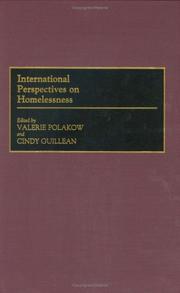| Listing 1 - 9 of 9 |
Sort by
|

ISBN: 0313308551 0313003971 9780313003974 9780313308550 9798400671524 Year: 2001 Volume: 135 Publisher: Westport, Conn. Greenwood Press
Abstract | Keywords | Export | Availability | Bookmark
 Loading...
Loading...Choose an application
- Reference Manager
- EndNote
- RefWorks (Direct export to RefWorks)
Homelessness --- Homelessness. --- Sans-abri --- Housing --- Poverty --- Homeless persons
Book
ISSN: 12698644 ISBN: 9782753575448 2753575444 2753585571 Year: 2021 Publisher: Rennes : Presses universitaires de Rennes,
Abstract | Keywords | Export | Availability | Bookmark
 Loading...
Loading...Choose an application
- Reference Manager
- EndNote
- RefWorks (Direct export to RefWorks)
Face aux phénomènes d’engorgement des urgences, les politiques de santé s’orientent aujourd’hui vers une restriction de l’accueil centré sur les pathologies graves. Cependant, pour de nombreuses personnes sans-abri, les urgences de l’hôpital public continuent de représenter une solution pour des besoins de soins ordinaires, d’assistance, voire d’hébergement. L’exemple du patient sans-abri pousse alors à son paroxysme les tensions qui se manifestent dans ces services, tiraillés entre « l’urgence médicale » et « l’urgence sociale ». Au moyen d’une enquête par immersion, cet ouvrage explore les formes de mobilisation des personnels des urgences face à la grande précarité des patients sans-abri. Comment gérer les priorités ? Comment assurer à la fois le soin, l’assistance, le tri des malades, la gestion des flux et la régulation des dépenses hospitalières ? À cet égard, la situation étudiée apparaît emblématique d’un ensemble plus vaste d’exigences en tension, voire en contradiction auquel l’hôpital public est aujourd’hui confronté.
Emergency Medical Services --- Poverty --- Homeless Persons --- Homeless persons --- Hospitals --- Medical personnel and patient --- Sans-abri --- Hôpitaux --- Relations personnel médical-patient. --- Urgence sociale. --- Sans-abri. --- Pauvreté. --- Service hospitalier d'urgences. --- Medical care --- Emergency services --- Soins médicaux. --- Services des urgences --- Aspect social. --- Hôpitaux --- Relations personnel médical-patient. --- Medical care. --- Sociology --- sociologie --- médecine --- santé
Book
ISBN: 0996324267 Year: 2018 Publisher: San Francisco, CA : University of California Medical Humanities Press,
Abstract | Keywords | Export | Availability | Bookmark
 Loading...
Loading...Choose an application
- Reference Manager
- EndNote
- RefWorks (Direct export to RefWorks)
"Soul Stories is an exploration of the boundaries of narrative within health and healing in the context of trauma and homelessness. It draws upon scholarly research across a range of disciplines, and is informed by Ensign's thirty years' experience as a nurse providing health care to people marginalized by poverty and homelessness, by her personal journey through homelessness as a young adult, and by her experience of teaching critical reflective practice to health science students. Soul Stories deepens our understanding of homelessness; trauma and resilience; gender-based violence; the role of narrative in health and healing; and ways we can humanize health care for patients, providers, and communities. It contributes to civically and community-engaged scholarship in the health humanities."--Amazon.com.
Nurses --- Narrative medicine --- Medicine and the humanities --- Homeless persons --- Infirmieres --- Medecine et sciences humaines. --- Medecine narrative. --- Sans-abri --- Narration --- Socioeconomic Factors --- Narrative Medicine --- Nursing Care --- Ill-Housed Persons --- Medicine and the humanities. --- Narrative medicine. --- Care --- Soins. --- psychology --- Care. --- United States
Book
ISBN: 144266374X 1442695781 9781442695788 9781442643284 1442643285 9781442611764 1442611766 9781442663749 Year: 2012 Publisher: Toronto
Abstract | Keywords | Export | Availability | Bookmark
 Loading...
Loading...Choose an application
- Reference Manager
- EndNote
- RefWorks (Direct export to RefWorks)
"Invisible Victims presents the first comprehensive, integrated study of the risks faced by homeless people and their attempts to find safety and security in often dangerous environments. Huey draws not only on current debates on security within criminology, but also on a decade's worth of her own field research on the victimization and policing of the homeless. A theoretically and empirically informed examination of the myriad issues affecting the homeless, Invisible Victims makes a compelling case for society to provide necessary services and, above all, a basic level of security for this population."--
Homeless persons --- Human security. --- Police. --- Cops --- Gendarmes --- Law enforcement officers --- Officers, Law enforcement --- Officers, Police --- Police forces --- Police --- Police officers --- Police service --- Policemen --- Policing --- Criminal justice, Administration of --- Criminal justice personnel --- Peace officers --- Public safety --- Security systems --- Non-traditional security (Human security) --- NTS (Human security) --- Security, Human --- Human rights --- Homeless adults --- Homeless people --- Street people (Homeless persons) --- Persons --- Homelessness --- Social conditions. --- Crimes against. --- Legal status, laws, etc. --- Sans-abri --- Crimes contre les sans-abri. --- Sécurité humaine. --- Conditions sociales.

ISBN: 1282025902 1442679530 9786612025907 9781442679535 9781282025905 0802042406 9780802042408 0802080847 9780802080844 6612025905 Year: 2003 Publisher: Toronto
Abstract | Keywords | Export | Availability | Bookmark
 Loading...
Loading...Choose an application
- Reference Manager
- EndNote
- RefWorks (Direct export to RefWorks)
In this groundbreaking work, urban anthropologist Rae Bridgman, in careful and intimate detail, explores the perspectives of the women who work and live at Savard's, a unique shelter for homeless women. Bridgman uses the design and development of Savard's - a housing model developed by women for women - as an opportunity to document the project's original vision and what happened once it opened. There are few rules at Savard's. Women may come and go as they wish, and referrals to other services are made only when a woman has indicated interest in taking action on her own behalf. It is a model that aims to provide a safe haven for the chronically homeless. The study traces the evolution of this type of shelter, providing qualitative research and useful analysis for academics, policy-makers, service providers, and activists. Based on many hours of participant observation as well as interviews and staff records, Safe Haven presents a distinct picture of the chronically homeless and those on the frontlines of this lifesaving service.
Homeless women --- Women's shelters --- Bag ladies --- Shopping bag ladies --- Homeless persons --- Women --- Battered women's shelters --- Crisis housing, Women's --- Emergency housing for women --- Refuges, Women's --- Shelters, Women's --- Women's crisis housing --- Women's emergency housing --- Women's refuges --- Emergency housing --- Housing --- Services for --- Savard's (Toronto, Ont.) --- Femmes sans-abri --- Maisons d'hébergement pour femmes --- Logement --- Ontario --- York
Book
ISBN: 9782874632310 2874632317 287463607X 2875581686 Year: 2010 Volume: *2 Publisher: Louvain-la-Neuve : Presses universitaires de Louvain,
Abstract | Keywords | Export | Availability | Bookmark
 Loading...
Loading...Choose an application
- Reference Manager
- EndNote
- RefWorks (Direct export to RefWorks)
Il est devenu aujourd’hui de plus en plus difficile de faire entendre la parole de ceux qui sont considérés comme exclus, marginaux, surnuméraires, désocialisés. C’est pourtant là l’enjeu du livre de Françoise Duby. En quoi les instances d’accueil et autres dispositifs disponibles dans le secteur de l’exclusion sont-ils au premier chef concernés par le maintien ou non de l’exclusion sociale ? Pour avoir vécu un temps avec la marginalité urbaine de la rue, F. Duby retrouve une nouvelle fois, à la maison d’accueil, les mêmes zones de sens éclatés, le même vide. Elle constate le même manque de profondeur des formations des accueillants, le même auto-enfermement sur des cercles très appauvris de socialité, de compétences… Comment échapper à l’auto-destruction, comment devenir un individu capable d’affronter les épreuves de la ville, de la vie ? Les réponses esquissées dans ce livre nous font percevoir l’enjeu décisif d’une écoute démocratique, d’un travail de recomposition des lieux d’accueil pour subvertir les jeux défensifs, les parcours brinqueballants, la servitude par trop volontaire.
Désinsertion sociale --- Exclusion (Sciences sociales) --- Exclusion [Social ] --- Exclusion sociale --- Marginal peoples --- Marginaliteit [Sociale ] --- Marginality [Social ] --- Marginalité sociale --- Précarisation --- Précarité sociale --- Précarité socio-économique --- Social exclusion --- Social marginality --- Sociale marginaliteit --- Sociale uitsluiting --- Uitsluiting [Sociale ] --- Vulnérabilité sociale --- Vulnérabilité socio-économique --- Personnes défavorisées --- Centres d'hébergement --- Sans-abri --- Marginality, Social --- People with social disabilities --- Group homes --- Homeless persons --- Personnes socialement défavorisées --- Marginality, Social. --- pauvreté --- sans domicile fixe (SDF) --- exclusion --- maison d’accueil --- Personnes socialement défavorisées --- Centres d'hébergement
Book
ISBN: 2874631493 2874635618 2875581678 9782874631498 Year: 2009 Publisher: Presses universitaires de Louvain
Abstract | Keywords | Export | Availability | Bookmark
 Loading...
Loading...Choose an application
- Reference Manager
- EndNote
- RefWorks (Direct export to RefWorks)
Belgique, France, Québec. Trois « pays » francophones, trois façons de nommer une figure de la pauvreté urbaine : sans-abri, sans domicile fixe, itinérant. Bien qu’immémoriale, cette figure a été perçue de façon nouvelle par nos contemporains au cours des années 1980. Parce que les catégories sont des constructions sociales qui tendent à s’institutionnaliser, elles méritent toute l’attention des chercheurs. Les figures de la pauvreté sont révélatrices d’un (dés)ordre social. Elles mettent en rapport les situations vécues et la « réaction sociale » à leur égard. C’est ce qui a poussé les auteurs de ce livre à proposer une relecture du phénomène, travail comparatif et de confrontation sur l’interdépendance entre contexte national et actions entreprises en direction des personnes. Ce travail est né d’une interrogation portée sur la place et l’utilité de la recherche face à l’installation et à la banalisation du phénomène du sans-abrisme dans les pays riches industrialisés : comment se construit un problème social dans différents contextes ? Comment les chercheurs délimitent-ils leur objet au regard du problème social considéré ? Quelle place occupe la recherche ? Comment est-elle mobilisée ? Comment se situe-t-elle par rapport à l’action politique ? Ces questions permettent de distinguer trois étapes essentielles, les trois parties de cet ouvrage. Tout d’abord, on décrit les éléments essentiels de la genèse de ce qui est apparu comme un problème social dans chacun des pays. Ensuite, on voit comment, face à ce problème social devenu problème public, la recherche s’est développée et organisée différemment, tant au niveau des institutions que des jeux d’acteurs et de leurs effets. Enfin, les parcours de recherche, dans leur grande diversité, permettent de reformuler les enjeux de connaissances, indissociables des situations qui les ont fait naître et des réactions sociales qui les ont accompagnés tout au long de ces deux dernières décennies.
Government policy. --- Homeless persons. --- Social Welfare & Social Work --- Social Sciences --- Social Welfare & Social Work - General --- Homeless adults --- Homeless people --- Street people (Homeless persons) --- Persons --- Homelessness --- Homelessness - Government policy --- sans-abri --- pauvreté --- ville --- sans domicile fixe (SDF) --- logement --- urgence sociale --- exclusion sociale --- itinérant --- dérive urbaine --- itinérance --- #SBIB:39A6 --- #SBIB:316.8H15 --- #SBIB:316.8H16 --- Etniciteit / Migratiebeleid en -problemen --- Welzijns- en sociale problemen: sociale ongelijkheid en armoede --- Welzijns- en sociale problemen: migranten, rassenrelaties

ISBN: 1442657316 1282023462 9786612023460 1442676485 9781442657311 9780802057891 0802057896 9780802067050 0802067050 9781442676480 9781282023468 0802029736 0802037747 9780802037749 9780802029737 1442659521 6612023465 9781442659520 Year: 1991 Publisher: Toronto [Ontario] : Ottawa, Ontario : University of Toronto Press, Canadian Electronic Library,
Abstract | Keywords | Export | Availability | Bookmark
 Loading...
Loading...Choose an application
- Reference Manager
- EndNote
- RefWorks (Direct export to RefWorks)
Webber cuts a comprehensible path through the tangle of forces, including family breakdown and social-service failure, that accelerate the tragedy of Canada's runaways. She suggests measures that might help more of them beat the streets.
Runaway teenagers --- Homeless youth --- Adolescents fugueurs --- Jeunes sans-abri --- Homeless persons --- Youth --- Street youth --- Runaway youth --- Teenagers --- #GGSB: Filosofie (18e eeuw) --- Aesthetics --- Intuition --- Transcendentalism --- Philosophy --- Philosophy, Modern --- Idealism --- Intuition (Psychology) --- Intuitionalism --- Cognition --- Insight --- Beautiful, The --- Beauty --- Esthetics --- Taste (Aesthetics) --- Art --- Criticism --- Literature --- Proportion --- Symmetry --- Psychology --- Kant, Immanuel --- Kant, I. --- Kānt, ʻAmmānūʼīl, --- Kant, Immanouel, --- Kant, Immanuil, --- Kʻantʻŭ, --- Kant, --- Kant, Emmanuel, --- Ḳanṭ, ʻImanuʼel, --- Kant, E., --- Kant, Emanuel, --- Cantơ, I., --- Kant, Emanuele, --- Kant, Im. --- קאנט --- קאנט, א. --- קאנט, עמנואל --- קאנט, עמנואל, --- קאנט, ע. --- קנט --- קנט, עמנואל --- קנט, עמנואל, --- كانت ، ايمانوئل --- كنت، إمانويل، --- カントイマニユエル, --- Kangde, --- 康德, --- Kanṭ, Īmānwīl, --- كانط، إيمانويل --- Kant, Manuel, --- Filosofie (18e eeuw) --- Radio broadcasting Aesthetics --- Canada. --- Canada (Province) --- Canadae --- Ceanada --- Chanada --- Chanadey --- Dominio del Canad --- Dominion of Canada --- Jianada --- Kʻaenada --- Kanada --- Ḳanadah --- Kanadaja --- Kanadas --- Ḳanade --- Kanado --- Kanak --- Province of Canada --- Republica de Canad --- Yn Chanadey --- Dominio del Canadá --- Kaineḍā --- Kanakā --- Republica de Canadá
Book
ISBN: 0776621432 0776621483 0776626132 9780776621487 9780776621470 0776621475 9780776621432 9780776621494 0776621491 Year: 2014 Publisher: University of Ottawa Press / Les Presses de l’Université d’Ottawa
Abstract | Keywords | Export | Availability | Bookmark
 Loading...
Loading...Choose an application
- Reference Manager
- EndNote
- RefWorks (Direct export to RefWorks)
"Brings together leading and emerging researchers to advance understanding of the complex relationships between homelessness and health. Covering a wide range of topics from youth homelessness to end-of-life care, contributors outline policy and practice recommendations to respond to this public health crisis."--back cover. Homelessness & Health in Canada explores, for the first time, the social, structural, and environmental factors that shape the health of homeless persons in Canada. Covering a wide range of topics from youth homelessness to end-of-life care, the authors strive to outline policy and practice recommendations to respond to the ongoing public health crisis. This book is divided into three distinct but complimentary sections. In the first section, contributors explore how homelessness affects the health of particular homeless populations, focusing on the experiences of homeless youth, immigrants, refugees and people of indigenous ancestry. In the second section, contributors investigate how housing and public health policy as well as programmatic responses can address various health challenges, including severe mental illness and HIV/AIDS. In the final section, contributors highlight innovative Canadian interventions that have shown great promise in the field. Together, they form a comprehensive survey of an all too important topic and serve as a blueprint for action.
Homelessness. --- Lodging-houses. --- Public housing. --- Delivery of Health Care --- Health Status --- Persons --- Residence Characteristics --- Environment, Controlled --- Sociology --- Demography --- Health Care Quality, Access, and Evaluation --- Named Groups --- Environment --- Social Sciences --- Patient Care Management --- Health Care --- Anthropology, Education, Sociology and Social Phenomena --- Environment and Public Health --- Epidemiologic Measurements --- Population Characteristics --- Health Services Administration --- Public Health --- Homeless Persons --- Housing --- Health Status Disparities --- Health Services Accessibility --- Social Welfare --- Health & Biological Sciences --- Social Medicine --- Homeless persons --- Homelessness --- Homeless Persons. --- Health Status Disparities. --- Health Services Accessibility. --- Social Welfare. --- Housing. --- Sans-abri --- Itinérance --- Health and hygiene --- Medical care --- Government policy --- Social conditions. --- Santé et hygiène --- Soins médicaux --- Politique gouvernementale --- Condition sociales. --- Canada. --- Family-Patient Lodging --- Patient-Family Lodging --- Family Patient Lodging --- Family-Patient Lodgings --- Lodging, Family-Patient --- Lodging, Patient-Family --- Lodgings, Family-Patient --- Lodgings, Patient-Family --- Patient Family Lodging --- Patient-Family Lodgings --- Community Services --- Services, Community --- Community Service --- Service, Community --- Welfare, Social --- Accessibility, Health Services --- Contraceptive Availability --- Health Services Geographic Accessibility --- Program Accessibility --- Access to Health Care --- Accessibility of Health Services --- Availability of Health Services --- Accessibility, Program --- Availability, Contraceptive --- Health Services Availability --- Health Status Disparity --- Disparities, Health Status --- Disparity, Health Status --- Status Disparity, Health --- Street People --- Homeless Person --- People, Street --- Person, Homeless --- Persons, Homeless --- Homeless adults --- Homeless people --- Street people (Homeless persons) --- Urban Renewal --- Public Assistance --- Medically Underserved Area --- Transients and Migrants --- Poverty --- public health policy --- homelessness --- Canada --- Dentistry --- HIV --- Mental disorder --- Supportive housing
| Listing 1 - 9 of 9 |
Sort by
|

 Search
Search Feedback
Feedback About UniCat
About UniCat  Help
Help News
News